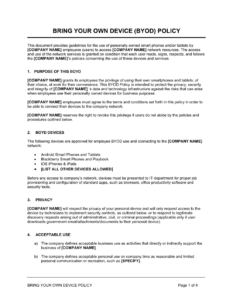A BYOD (Bring Your Own Device) Acceptable Use Policy is a set of rules and guidelines that govern the use of personal devices in the workplace. It helps to ensure that employees use their devices responsibly and in a manner that does not compromise the security or productivity of the organization. Having an acceptable use policy in place is an essential part of BYOD implementation, and this template provides a starting point for organizations to customize according to their specific needs and requirements. It addresses key areas such as security, data privacy, network access, and consequences for violations, helping to protect both the employer and the employee.
The BYOD acceptable use policy template ensures that all employees are aware of the guidelines and expectations for using their own devices in the workplace. It outlines the permitted and prohibited uses of personal devices, emphasizing the importance of safeguarding company data and maintaining appropriate conduct while using devices on the company’s network. By establishing clear rules and regulations, the policy helps to minimize risks and ensure a consistent approach to BYOD within the organization. This template is designed to be customizable, allowing organizations to tailor it to their unique requirements and address specific concerns related to their industry, size, and risk profile.
Responsibilities of Employees
Intro: Establishing clear responsibilities for employees is crucial in a BYOD environment. This section outlines the expected behaviors and actions employees must adhere to while using their personal devices for work purposes.
1. Data Security: Employees are responsible for protecting the confidentiality and integrity of company data accessed or stored on their devices. They must implement appropriate security measures to prevent unauthorized access, use, or disclosure of sensitive information.
2. Software and Updates: Employees are expected to keep their devices updated with the latest security patches and software versions to minimize vulnerabilities. They must also install and maintain reputable antivirus and anti-malware software to protect against cyber threats.
3. Network Access and Usage: Employees must only access company resources and networks through authorized and secure channels. Unauthorized access or attempts to bypass security measures are strictly prohibited. They should also use company networks responsibly, avoiding excessive bandwidth usage or engaging in activities that may compromise network performance.
4. Compliance with Company Policies: Employees must adhere to all company policies and procedures, including those related to data protection, privacy, and information security. Any violations of these policies may result in disciplinary action.
Organizational Responsibilities
Intro: The organization also has certain responsibilities in a BYOD environment. This section highlights the measures the organization should take to support and monitor the implementation of the BYOD acceptable use policy.
1. Provide Technical Support: The organization should provide adequate technical support to employees using personal devices for work purposes. This may include assistance with device configuration, software installation, and troubleshooting any technical issues.
2. Regular Training and Awareness: The organization should conduct regular training sessions to educate employees about the BYOD policy, data security best practices, and responsible device usage. This helps ensure that employees are well-informed and aware of their responsibilities in maintaining a secure BYOD environment.
3. Data Backup and Recovery: The organization should implement a data backup and recovery plan to protect company data stored on employees’ personal devices. This ensures that critical information is not lost or compromised in the event of device loss, theft, or damage.
4. Monitoring and Enforcement: The organization should have mechanisms in place to monitor compliance with the BYOD policy and enforce its provisions. This may include regular audits, reviews of device logs, and disciplinary action for violations.
Conclusion
The BYOD acceptable use policy template provides a comprehensive framework for organizations to effectively manage and govern the use of personal devices in the workplace. By clearly defining the responsibilities of both employees and the organization, it establishes a foundation for a secure and productive BYOD environment. Customization of the policy to suit specific organizational needs ensures that it remains relevant and effective in addressing emerging challenges and risks associated with BYOD adoption.
Organizations should regularly review and update their BYOD acceptable use policy as technology evolves and new threats emerge. This ensures that the policy remains current and aligned with industry best practices. By fostering a culture of responsible device usage and adherence to the policy, organizations can leverage the benefits of BYOD while minimizing potential risks.
FAQs
What is the purpose of a BYOD acceptable use policy template?
A BYOD acceptable use policy template provides a set of guidelines and rules for employees using their personal devices for work purposes. It outlines the permitted and prohibited uses, data security requirements, and employee responsibilities.
Who should use a BYOD acceptable use policy template?
Organizations that allow employees to use their personal devices for work should implement a BYOD acceptable use policy. This includes businesses of all sizes, educational institutions, and government agencies.
What are some key elements to include in a BYOD acceptable use policy template?
A BYOD acceptable use policy template should address employee responsibilities, such as data protection, software updates, and appropriate network usage. It should also outline the organization’s responsibilities, including technical support, training, and regular monitoring.
